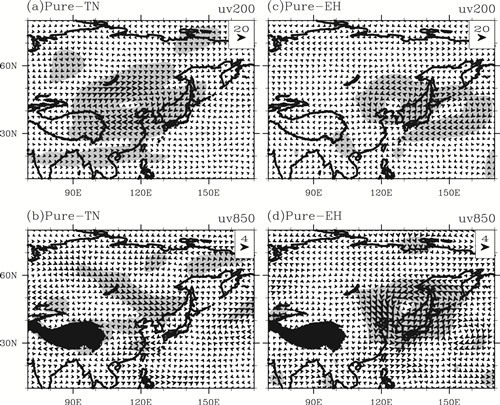Extreme heat in China
Date:2016-03-01
Against the background of global warming, high temperature weather has become more frequent on the global scale, significantly impacting human health as well as social and economic activities. Therefore, high temperature weather has become an important public concern, and is thus also receiving an increasing amount of attention in the scientific literature.
In a paper published in Atmospheric and Oceanic Science Letters in March 2016, Prof. LU Riyu (Institute of Atmospheric Physics, Chinese Academy of Sciences) and Dr. CHEN Ruidan (Sun Yat-sen University) review recent research progress on extreme high temperatures in China during summer (Lu and Chen, 2016). The focus is on the variation in extreme heat and tropical nights (i.e., high temperature at night), and the factors of influence.

Figure 1. Linear trends in the number of extreme heat days (with maximum temperature greater than 35°C) for the years from (a) 1958 to 2008, (b) 1958 to 1983, and (c) 1984 to 2008. The marks are proportional to the values of the trend, with red dots for positive values and green dots for negative values. Only the stations with a significant trend level above 95% are displayed. Units: d/10 yr. (Wei and Chen, 2009).
Generally, over most parts of the country, China has experienced a significant warming trend in recent decades. The details of the extreme heat trend, however, show a complex structure, with the trend being dependent on the study period and the latitude of stations. For instance, Wei and Chen (2009) reported that for the period 1958–2008, the frequency of extreme heat shows an increasing trend in southern and northwestern China and a decreasing trend in central China (Figure 1a). However, the distributions are quite different for the first (Figure 1b) and second half (Figure 1c) of this period.

Figure 2. Composite anomalies of (a, c) 200-hPa and (b, d) 850-hPa wind (units: m s?1) for (a, b) tropical nights and (c, d) extreme heat in Beijing. (Chen and Lu, 2014a).
Additionally, circulation patterns associated with extreme heat and tropical nights may be distinct. Taking Beijing as an example, Chen and Lu (2014a) indicated that Beijing tropical nights are associated with an upper-tropospheric anticyclonic anomaly to the northwest and a lower-tropospheric anticyclonic anomaly to the southeast of the city (Figures 2a and 2b). In contrast, extreme heat is manifested in the form of a cyclonic anomaly to the northeast of North China in both the upper and lower troposphere (Figures 2c and 2d). The difference in circulation leads to significantly different humidity anomalies, which are crucial for the difference between tropical nights and extreme heat.
Most tropical nights (extreme heat) occur under wetter (drier) air conditions. However, Chen and Lu (2014b) identified that atypical phenomena exist in Beijing, i.e., dry tropical nights and wet extreme heat. They found that, in addition to meteorological conditions, temperature persistence between the day and night contributes greatly to these atypical phenomena: The maximum daytime temperature (minimum nighttime temperature) prior to a dry tropical night (wet extreme heat) is obviously higher than that prior to a wet tropical night (dry extreme heat) (Figure 3), suggesting a complicated mechanism for inducing tropical nights and extreme heat.

Figure 3. Probability distribution of the preceding (a) maximum temperature (Tmax; units: °C) for Beijing tropical nights and (b) minimum temperature (Tmin; units: °C) for Beijing extreme heat under conditions of higher humidity (solid lines) and lower humidity (dashed lines).(Chen and Lu, 2014b).
Other factors influencing the occurrence of extreme heat, such as sea surface temperature and the underlying land surface, are also addressed in the paper. Furthermore, potential research topics for the future are discussed, including the need for specific studies on the extreme high temperature event that occurred in the summer of 2013, as well as more studies on tropical nights and the reasons for regional features of projected change in heat extremes under global warming. More work on seasonal forecasts of temperature anomalies is also required.
References
Wei, K., and W. Chen. 2009. “Climatology and trend of high temperature extremes across China in summer.” Atmospheric and Oceanic Science Letters 2: 153–158.
Chen, R., and R. Lu. 2014a. “Large-scale circulation anomalies associated with ‘Tropical Night’ weather in Beijing, China.” International Journal of Climatology 34: 1980–1989.
Chen, R., and R. Lu. 2014b. “Dry tropical nights and wet extreme heat in Beijing: Atypical configuration between high temperature and humidity.” Monthly Weather Review 142: 1792–1802.
Lu, R., and R. Chen. 2016. “A review of recent studies on extreme heat in China.” Atmospheric and Oceanic Science Letters 9: 114–121.
Contact: Prof. LU Riyu, lr@mail.iap.ac.cn
